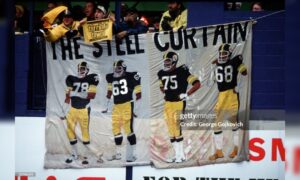By Matthew Marczi
The overhaul along the offensive line of the Pittsburgh Steelers in 2013 has already been covered extensively, including by myself, earlier this week. But, of course, there are several other changes to the lineup during the team’s makeover for next season, and the biggest—or at least the most expensive—is replacing wide receiver Mike Wallace, who cashed in his ‘60 Minutes’ notoriety for $60 million with the Miami Dolphins this season.
If it was not already clear that the Steelers intended to act on this replacement by inserting fourth-year receiver Emmanuel Sanders into the starting lineup, the team’s electing to match the one-year, $2.5 million offer sheet signed by Sanders from the New England Patriots, nearly doubling what they had intended to pay the 26-year old, should have made it so.
There are, of course, a lot of questions surrounding Sanders, from his durability to his ability to separate from defenders. After missing five games in 2011, Sanders was actually the only receiver to play in every game this past season when Wallace missed the first game of his career in the meaningless season finale.
As far as his performance during the year goes, he did have career highs nearly across the board. His 44 receptions doubled his total from the previous season, while the 626 receiving yards was a significant improvement upon the 376 from his rookie year. He also averaged a career-best 14.2 yards per reception.
On the other hand, he also had just one touchdown all season, after having four during his first two seasons as a reserve. As a starter, he will, naturally, have to do a lot more work in the end zone, especially with Wallace taking his 32 touchdowns in four seasons with him to South Beach.
This, to my mind, will be the main concern of the offense in 2013; replacing not simply the numbers of players lost or injured, but replicating their scoring. In fact, the Steelers must be even better this season getting the ball into the end zone if they hope to get back to the playoffs.
Tight end Heath Miller, who tied the team lead in touchdowns by matching Wallace’s eight from a year ago, is not even guaranteed to be ready to go for Week 1, and will assuredly require several weeks, if not all season, to get himself back into football shape. Wallace, of course, is gone. That is a lot of red zone targets to make up.
In 2012, Sanders was targeted on just five passes in the red zone, catching three of them for 16 yards and his sole touchdown, which came against the New York Giants. Miller and Wallace combined for 22 receptions on 36 targets for 126 yards and 10 touchdowns, while Antonio Brown—now the team’s de facto number one receiver—caught six of nine passes for 39 yards and four touchdowns.
Sanders was targeted on 75 passes throughout the season, meaning 70, or 93%, of his targets took place on 80% of the field. Why do his targets decrease closer to the goal line? For one, chances are good that he was at best the fourth option on most passing plays in the red zone, especially with Miller being a more dangerous threat on a short field due to his size.
Yet even Jerricho Cotchery and fullback Will Johnson received four targets apiece in the red zone, so there should certainly be more something to such few targets for Sanders close to the goal line.
And there does appear to be some suggestion that this number is an outlier. Despite racking up a career-high 762 snaps on offense, or 68% of all offensive plays, the five red zone targets was the fewest of his career.
In 2011, while playing in just 11 games, Sanders caught four of six passes thrown his way in the red zone, and made good on them for 32 yards and two touchdowns. In his rookie year, he was targeted eight times in the red zone, catching five passes for 33 yards and one touchdown. His 14 targets over his first two seasons was actually just one shy of Miller’s total during that stretch.
So was it simply a matter of a new scheme focusing more on the tight end in close quarters, or is there more to the drop in red zone targets for the player the Steelers intend to turn into a starter? This is just one of the many questions that need answering on the field for the Steelers in 2013, and Sanders must provide the answer.







